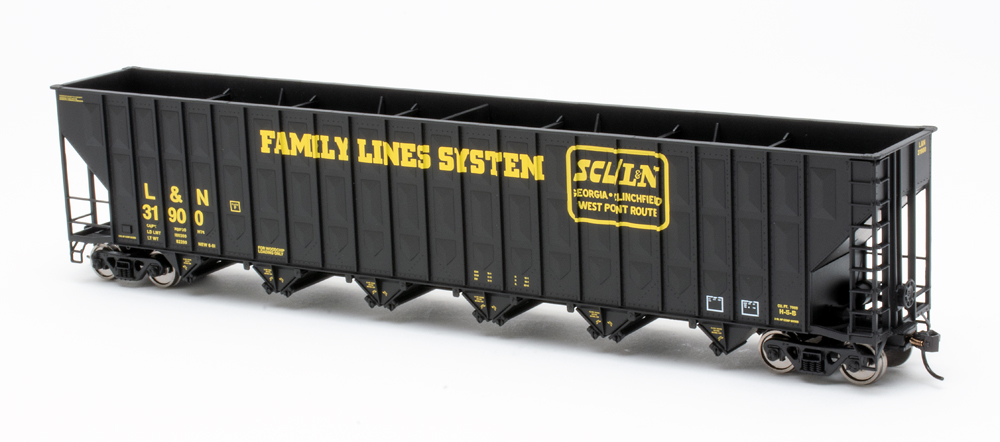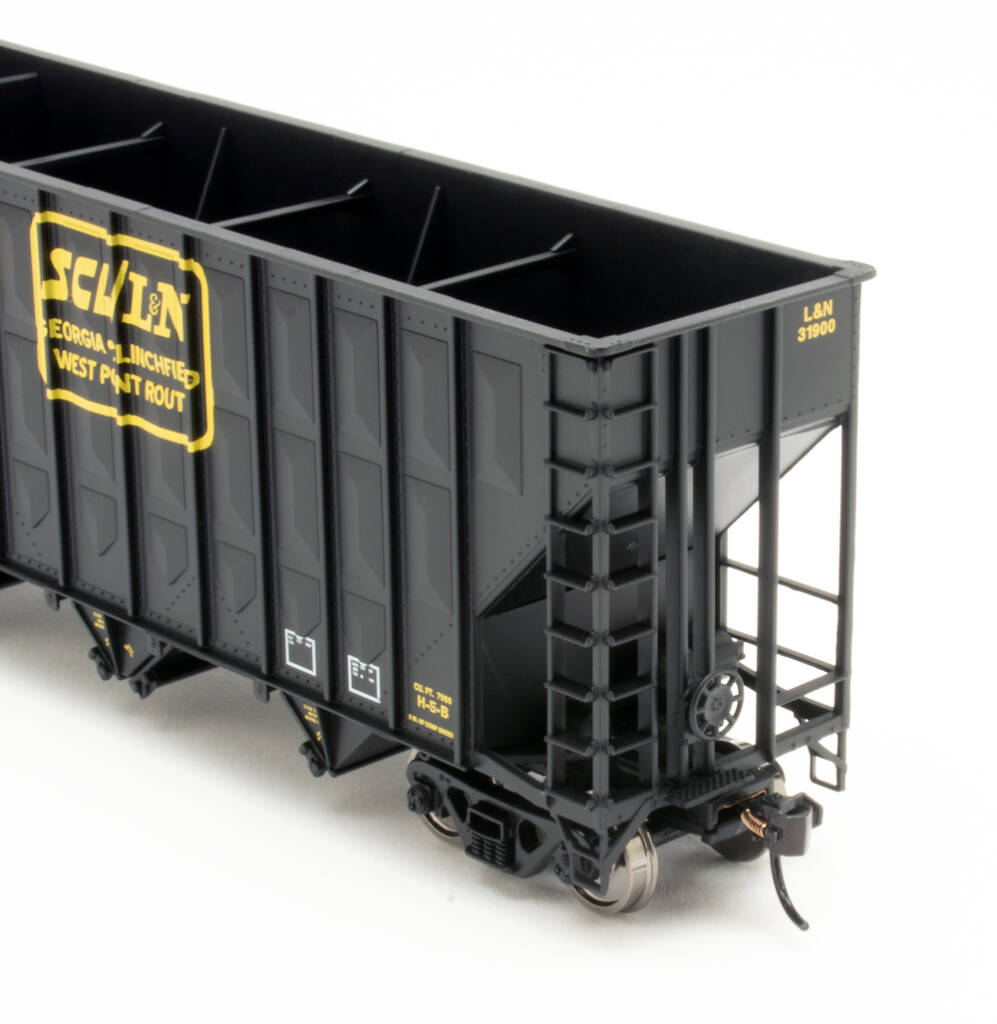
The Greenville 73-foot wood-chip hopper has returned to the Wm. K. Walthers Inc. HO scale freight car lineup. The model, part of the Mainline series, is based on a prototype designed for transporting wood chips between sawmills and paper mills.
Prototype history
Greenville Steel Car Co., located in its namesake in Pennsylvania, produced the 7,000-cubic-foot capacity wood-chip hopper from the early 1970s to the early 1980s. Among the railroads to roster the six-bay hopper were Apalachicola Northern, Georgia RR, Kansas City Southern, Missouri Pacific, and Seaboard Coast Line.
The sample we received is decorated in the Family Lines System paint scheme as Louisville & Nashville No. 31900, part of the 31900 through 31999 series. The 100 full-size cars were built by Ortner Freight Car Co. in 1981 under job number OC-331. The L&N cars were part of a joint order with Seaboard Coast Line, which ordered 200 cars (SCL 196275 through 196474). In elevation drawings supplied by the Louisville & Nashville Historical Society, it notes Greenville Steel Car Co. die-pressed side sheets and corner caps were used on the L&N and SCL cars.
When L&N and Seaboard Coast Line merged to form the Seaboard System in 1982, the L&N cars were renumbered SBD 434100 through 434199. After Seaboard System rebranded as CSX Transportation in July 1986, the hoppers received CSXT reporting marks but stayed in the same number series.
Welcome back!

We last reviewed the Walthers Greenville wood-chip hopper in the August 2003 issue. Back then, the model had plastic wheelsets mounted on brass axles, modeler-installed wire grab irons for the end sills, and Bachmann E-Z Mate plastic knuckle couplers. Today, the hopper has metal wheelsets mounted on plastic axles and Proto-Max metal couplers. There are drill-starter points on the end sills, but grab irons are not included.
The model has an injection-molded plastic body with raised panels on the sides and crisp rivet detail. The panel detail is not embossed on the car’s interior, nor is there any rivet detail inside the car.
The end cages have molded corner, end, and brake posts; ladder stiles; ladder rungs; and grab irons. The brake wheel, air reservoir, brake cylinder, and control valve are all freestanding details.

Inside, the car has crisply defined cross ridge and longitudinal hood floor sheet detail. Additional interior items include crossties, gussets, and a partition. These are used on the full-size cars to stabilize the high sides.

Most of the hopper’s weight comes from a metal casting that includes the body bolsters, center sill, and draft-gear boxes. The casting also has triangle-shaped pieces that fill the valleys between the hoppers. Plastic was used for the hopper doors, latches, and screw-mounted draft-gear box covers.
Prototype vs. model
Our sample features smooth and evenly applied black paint, though the interior should be light gray. The yellow lettering is opaque throughout, which is no easy task considering it was applied over a dark base. I was especially impressed that there were no gaps where the printing wrapped around the exterior posts. Well done! The lettering placement closely follows prototype photos of cars from this series. However, the SCL and L&N heralds, as well as the “Family Lines System” lettering are slightly oversized.
Drawings of the Greenville 7,000-cubic-foot capacity wood-chip hopper were published in the April 1999 issue of Railroad Model Craftsman magazine. The exterior dimensions match published data. The interior length and width are both around a scale 5” too short, which is typical on open hoppers due to limitations in the injection-molding process.
Because of its height and distinct die-pressed side panels, the Greenville 7,000-cubic-foot capacity wood-chip hopper was a signature car of its era. After a lengthy hiatus, it’s good to see the model back in the Walthers product lineup.
Facts & features
Price: $39.98 (undecorated, $34.98)
Manufacturer
Wm. K . Walthers Inc.
5601 W. Florist Ave.
Milwaukee, WI 53218
Era: early 1970s to present
Road names: Louisville & Nashville (Family Lines System), Apalachicola Northern, Atlanta & St. Andrews Bay, CSX, Norfolk Southern, Seaboard System, and Southern Ry. (black and brown schemes). Four to six road numbers per scheme; also available undecorated.
Features
- 36” turned-metal wheels on plastic axles, correctly gauged
- Minimum radius, 18”; recommended radius, 22” or larger
- Proto-Max metal couplers, at correct height
- Weight: 6.2 ounces, .4 ounce too heavy per National Model Railroad Association Recommended Practice 20.1













I’d love to see this car in N-scale. I have a layout that is the Southern later N.S. S-line through Western North Carolina, east of Asheville. A lot of these car hauled wood pulp from a location near Old Fort to a plant in Ashville to make paper cups.